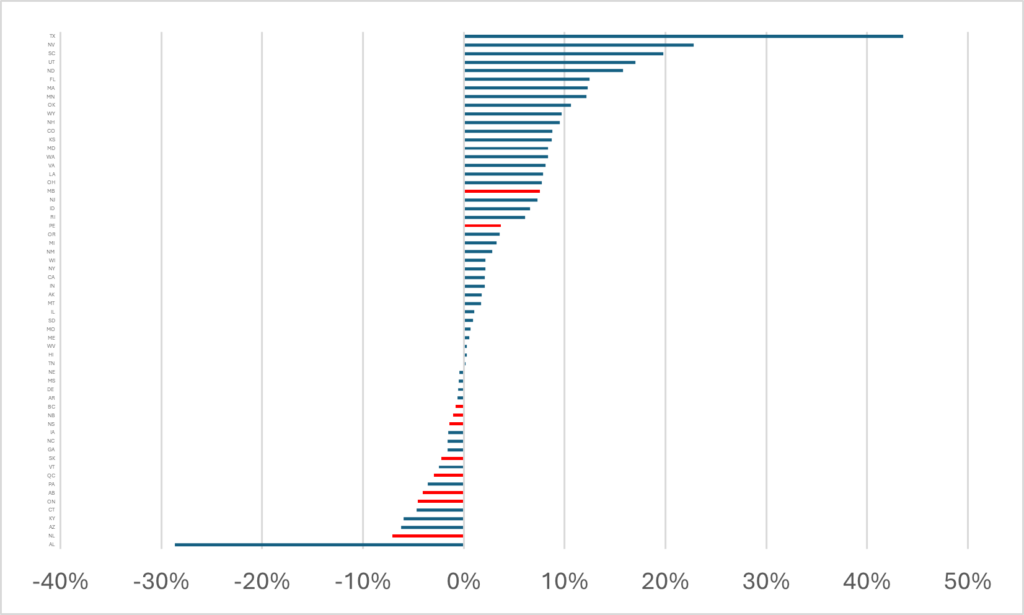I was perusing a Chronicle of Higher Education article on American state expenditures on post-secondary education when I saw a completely jaw-dropping graph.
Figure 1: Jaw-Dropping Visual from The Chronicle on State Funding

I mean…wow. Right?
This figure actually lines up with something I had noticed a few months ago about state-level spending in the 1960s and 1970s. Though there is lots of talk about “wars on higher education” in the United States; in fact, there isn’t a very tight fit between the cultural battle over higher education and actual state level expenditures.
Obviously, being the data maven that I am, I decided to take a cross-border comparative look at the data. Just so we’re clear on what’s being counted here: the state-level American data is from something called the “Grapevine” report (most recent data available here, historical data available here), while the Canadian data is from budgetary data that I collect and report on annually (see here for an example). The data is for total expenditures on post-secondary education; both transfers to institutions and student aid expenditures.
The money graph is Figure 2, which shows changes in provincial and state expenditures across the last decade in the United States and Canada. The story is simple: after inflation, Canadian provinces are spending 5% less on post-secondary education than they were a decade ago. American states, on the other hand, have increased their spending by 24% over the last decade after inflation.
Figure 2: Change in Real State/Provincial Expenditures on Post-Secondary Education, Canada vs. US, 2013-14 to 2023-24 (2013-14 = 100)

We can examine this data a bit further by breaking it down by jurisdiction. If we look at this over a 10-year span, the best-performing Canadian jurisdiction is Quebec, which has seen a 14% increase in real spending over the past decade. But even that does not put the province in the top 50% of jurisdictions in North America, and certainly nowhere near top performers such as Utah (+75%), Colorado (69%) and South Carolina (56%). Canadian provinces are, on the other hand, overrepresented among the laggards, with Newfoundland (-36%), Saskatchewan (-24%) and Alberta (-20%) making up 3 of the four worst performers (all figures naturally adjusted for inflation, Canadian jurisdictions in red).
Figure 3: 10-year Change in Real Expenditures on Post-Secondary Education, to 2023-24

We can examine these figures a bit more by using different time intervals. Figure 4 shows change over 5 years (since 2018-19). Here, a couple of Canadian provinces (BC and Quebec) do crawl into the top half of all jurisdictions, with real growth of about 7% apiece. This, however, is a long way off the top spenders Texas (45%), Utah (36%) and South Carolina (35%) (notice how it’s so-called red states leading the way? Not what you expected, is it?). Canadian provinces are over-represented at the bottom end, with three provinces—Newfoundland (-15%), Ontario (-20%) and Alberta (-30%)—making the bottom five.
Figure 4: 5-year Change in Real Expenditures on Post-Secondary Education, to 2023-24

Just for giggles, let’s do this again at the 1-year level, looking at change between 22-23 and 23-24. Here, Prince Edward Island (+4%) and Manitoba (+8%) creep into the top half, but again miles off Texas (+44%), Nevada (+23%) and South Carolina (+20%). Meanwhile, all eight of the other provinces are in negative territory after inflation, led as usual by Newfoundland (-7%), Ontario (-5%) and Alberta (-4%).
Figure 5: 1-year Change in Real Expenditures on Post-Secondary Education, to 2023-24

Canada has been through this show before. Anyone old enough to remember the 1990s remembers that US expenditures on higher education rose at the same time that Canadian governments were cutting funding to the sector, and that eventually, this led to an exodus of Canadian talent to better-funded US institutions. We’re headed in exactly the same direction, and apparently none of our provincial governments, with the possible exception of Quebec, seems to give a damn.
Regular reminder to Canadian universities: governments are not coming to save you. You’re on your own. Good luck to all.

 Tweet this post
Tweet this post

Quebec might be funding higher ed better than most in Canada with the data presented, but given the tuition policy changes imposed on McGill and Concordia, there is more than one way for a government to under-fund universities
“notice how it’s so-called red states leading the way? Not what you expected, is it?”
It’s possible to square the circle between the apparent “war on higher education” and the increase in spending in one of two ways:
1. What is this new spending on? If it’s all going to technical training and student amenities, then the red states might, like the government of Saudi Arabia, be trying to have a lot of technical learning without the potentially subversive intellectualism that universities generally house.
2. What is the total spending? Are the red states — and US states generally — just making up for apocalyptic cuts in the recent past? If so, they might be spending far more than recently, but still much less per student than Canadian provinces.
The two might also be combined, if the cuts of the past were used to destroy humanities, and the increases of the present are being used to substitute STEM and professional training.
None of which is to say that an increase in spending wouldn’t be welcomed by our colleagues south of the border, but we need to know more to see if it’s an unalloyed good, or if it actually places American schools ahead of their Canadian counterparts.